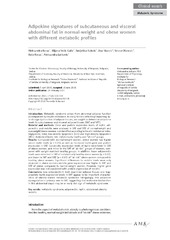Приказ основних података о документу
Adipokine signatures of subcutaneous and visceral abdominal fat in normal-weight and obese women with different metabolic profiles
| dc.creator | Korać, Aleksandra | |
| dc.creator | Srdić-Galić, Biljana | |
| dc.creator | Stančić, Ana | |
| dc.creator | Otašević, Vesna | |
| dc.creator | Korać, Bato | |
| dc.creator | Janković, Aleksandra | |
| dc.date.accessioned | 2021-04-15T10:48:55Z | |
| dc.date.available | 2021-04-15T10:48:55Z | |
| dc.date.issued | 2021 | |
| dc.identifier.issn | 1734-1922 | |
| dc.identifier.uri | https://doi.org/10.5114/aoms/92118 | |
| dc.identifier.uri | https://radar.ibiss.bg.ac.rs/handle/123456789/4197 | |
| dc.description.abstract | Introduction: Metabolic syndrome arises from abnormal adipose function accompanied by insulin resistance. As early factors reflecting/impacting lip-id storage dysfunction of adipose tissues, we sought to determine adipokine levels in subcutaneous and visceral adipose tissues (SAT and VAT). Material and methods: Gene and protein expression levels of leptin, adi-ponectin, and resistin were analysed in SAT and VAT of normal-weight and overweight/obese women, subclassified according to insulin resistance index, triglyceride, total, low-density lipoprotein (LDL) and high-density lipoprotein (HDL) cholesterol levels into metabolically healthy and "at risk" groups. Results: Compared with normal-weight women, obese women had higher serum leptin levels (p < 0.05), as well as increased leptin gene and protein expression in VAT. Conversely, expression levels of leptin were lower in SAT of obese women, and minor in the SAT of "at risk" groups of women, compared with weight-matched healthy groups. In addition, lower adiponectin levels were detected in SAT of metabolically healthy obese women (p < 0.01), and lower in SAT and VAT (p < 0.05) of "at risk" obese women compared to healthy, obese women. Significant differences in resistin levels were only observed in obese women; resistin gene expression was higher in VAT and SAT of obese, compared to normal-weight women. However, higher gene expression was not consistent with protein expression of resistin. Conclusions: Low adiponectin in both examined adipose tissues and inappropriate leptin expression levels in SAT appear to be important characteristics of obesity-related metabolic syndrome. Intriguingly, this adipokine dysregulation is primary seen in SAT, suggesting that endocrine dysfunction in this abdominal depot may be an early risk sign of metabolic syndrome. | |
| dc.publisher | Termedia Sp. z.o.o. | |
| dc.relation | info:eu-repo/grantAgreement/MESTD/Basic Research (BR or ON)/173055/RS// | |
| dc.rights | openAccess | |
| dc.rights.uri | https://creativecommons.org/licenses/by-nc/4.0/ | |
| dc.source | Archives of Medical Science | |
| dc.subject | Abdominal obesity | |
| dc.subject | Adiponectin | |
| dc.subject | Leptin | |
| dc.subject | Metabolic syndrome | |
| dc.subject | Resistin | |
| dc.title | Adipokine signatures of subcutaneous and visceral abdominal fat in normal-weight and obese women with different metabolic profiles | |
| dc.type | article | en |
| dc.rights.license | BY-NC | |
| dcterms.abstract | Кораћ, Aлександра; Јанковић, Aлександра; Кораћ, Бато; Станчић, Aна; Оташевић, Весна; Срдић-Галић, Биљана; | |
| dc.rights.holder | © 2020 Termedia & Banach. | |
| dc.citation.issue | 2 | |
| dc.citation.volume | 17 | |
| dc.identifier.doi | 10.5114/aoms/92118 | |
| dc.identifier.pmid | 33747267 | |
| dc.identifier.scopus | 2-s2.0-85103599188 | |
| dc.identifier.wos | 000636059700006 | |
| dc.citation.apa | Korac, A., Srdic-Galic, B., Stancic, A., Otasevic, V., Korac, B., & Jankovic, A. (2021). Adipokine signatures of subcutaneous and visceral abdominal fat in normal-weight and obese women with different metabolic profiles. Archives of Medical Science, 17(2), 323–336. | |
| dc.citation.vancouver | Korac A, Srdic-Galic B, Stancic A, Otasevic V, Korac B, Jankovic A. Adipokine signatures of subcutaneous and visceral abdominal fat in normal-weight and obese women with different metabolic profiles. Arch Med Sci. 2021;17(2):323–36. | |
| dc.citation.spage | 323 | |
| dc.citation.epage | 336 | |
| dc.type.version | publishedVersion | |
| dc.identifier.fulltext | https://radar.ibiss.bg.ac.rs/bitstream/id/8380/bitstream_8380.pdf | |
| dc.citation.rank | M21 |

